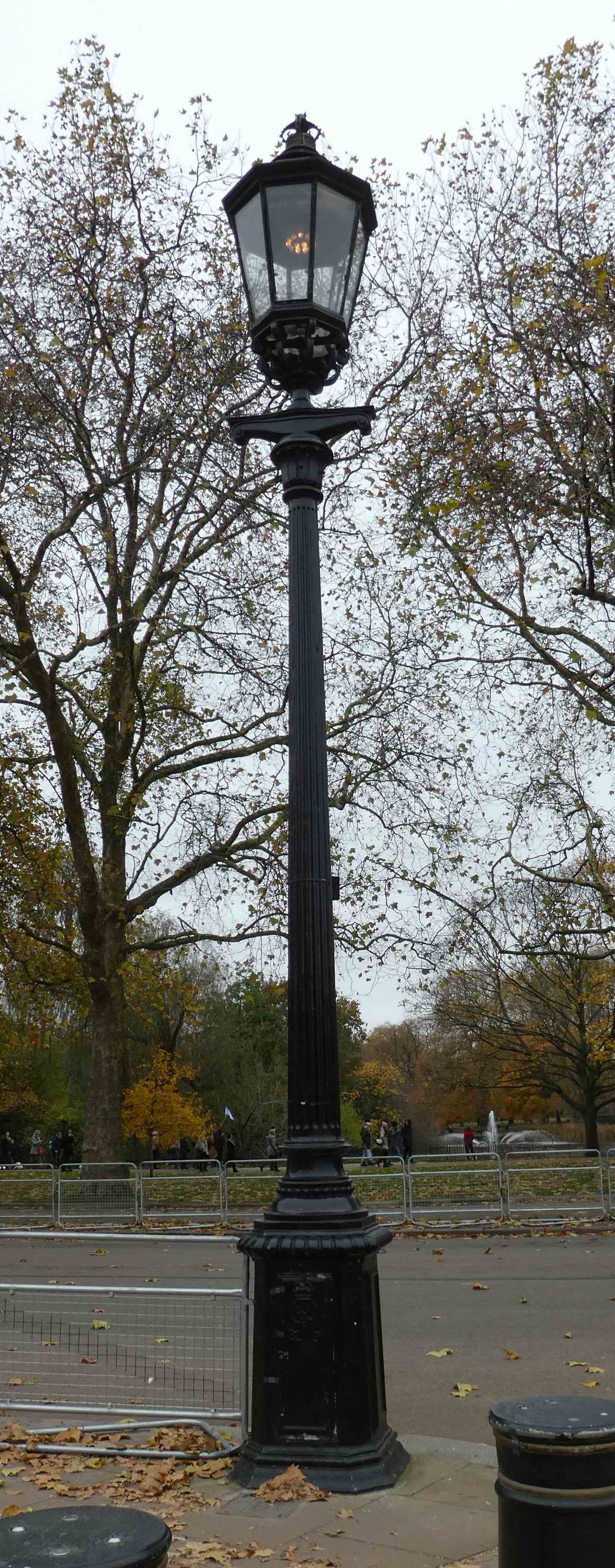A fully illustrated version of this walk, that's easy to print, is available as a PDF file by clicking here
To return to the first part of the walk, click here
To return to the first part of the walk, click here
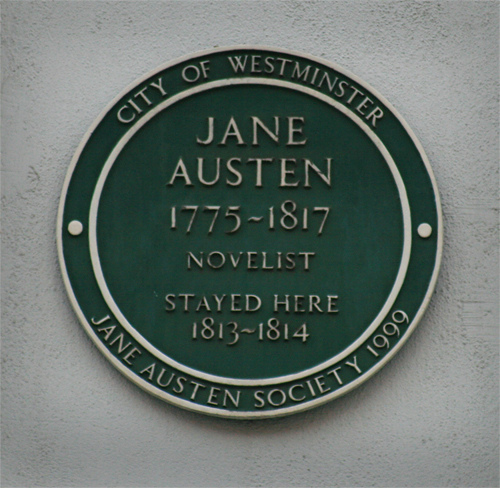
After you finish exploring the church and garden turn right in the Piazza and right again into, the gas illuminated,
Henrietta Street.
There is a green City of Westminster plaque for the novelist, Jane Austen, who stayed in 1813- 1814, above no. 10 on the left.
She was an English novelist known primarily for her six major novels which interpret and comment upon the British landed gentry at the
end of the 18th century. Austen’s plots often explore the dependence of women on marriage in the pursuit of favourable social standing
and economic security. She was commemorated by a stamp issue in 1975, on the 200th anniversary of her birth.
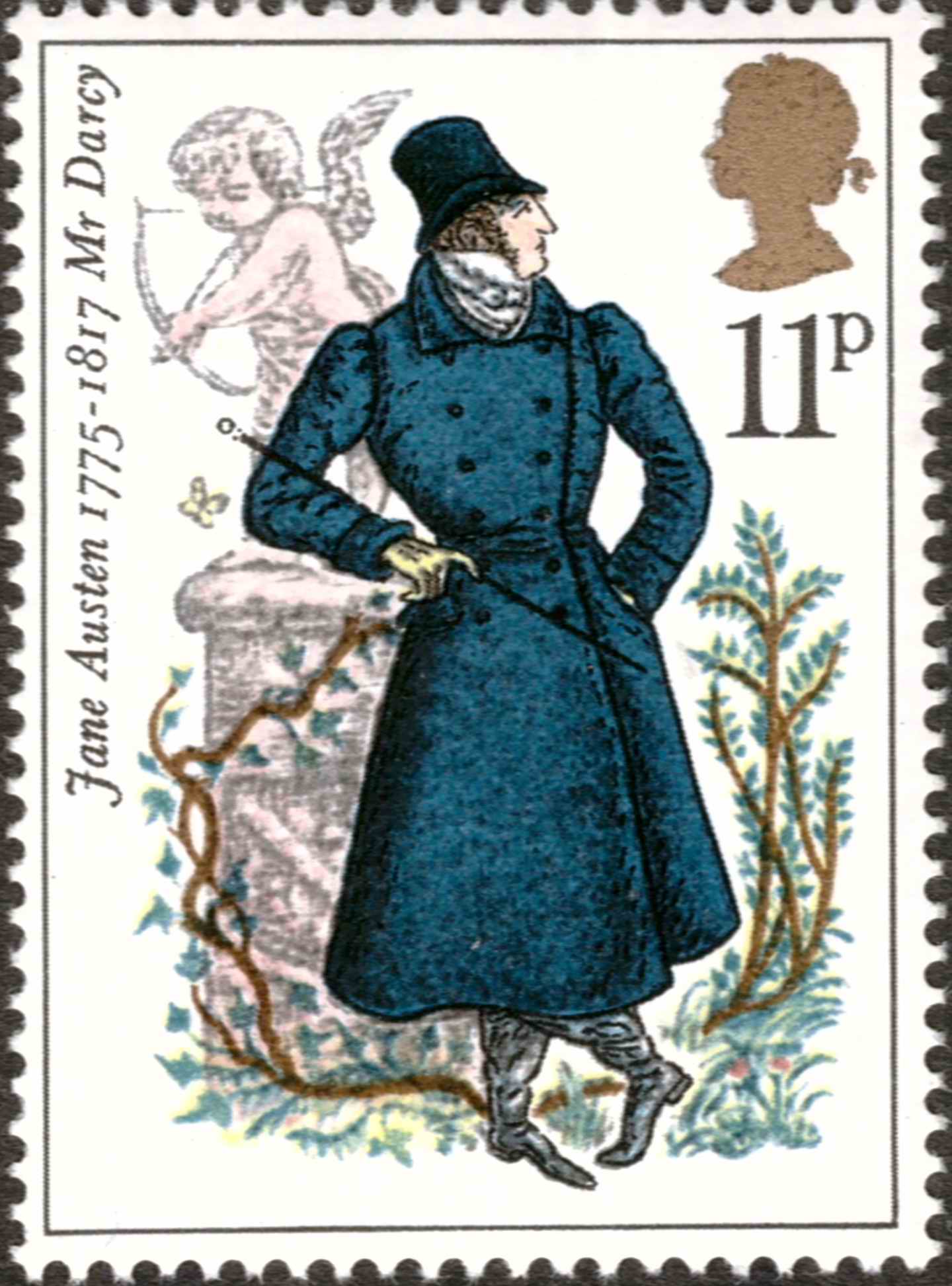
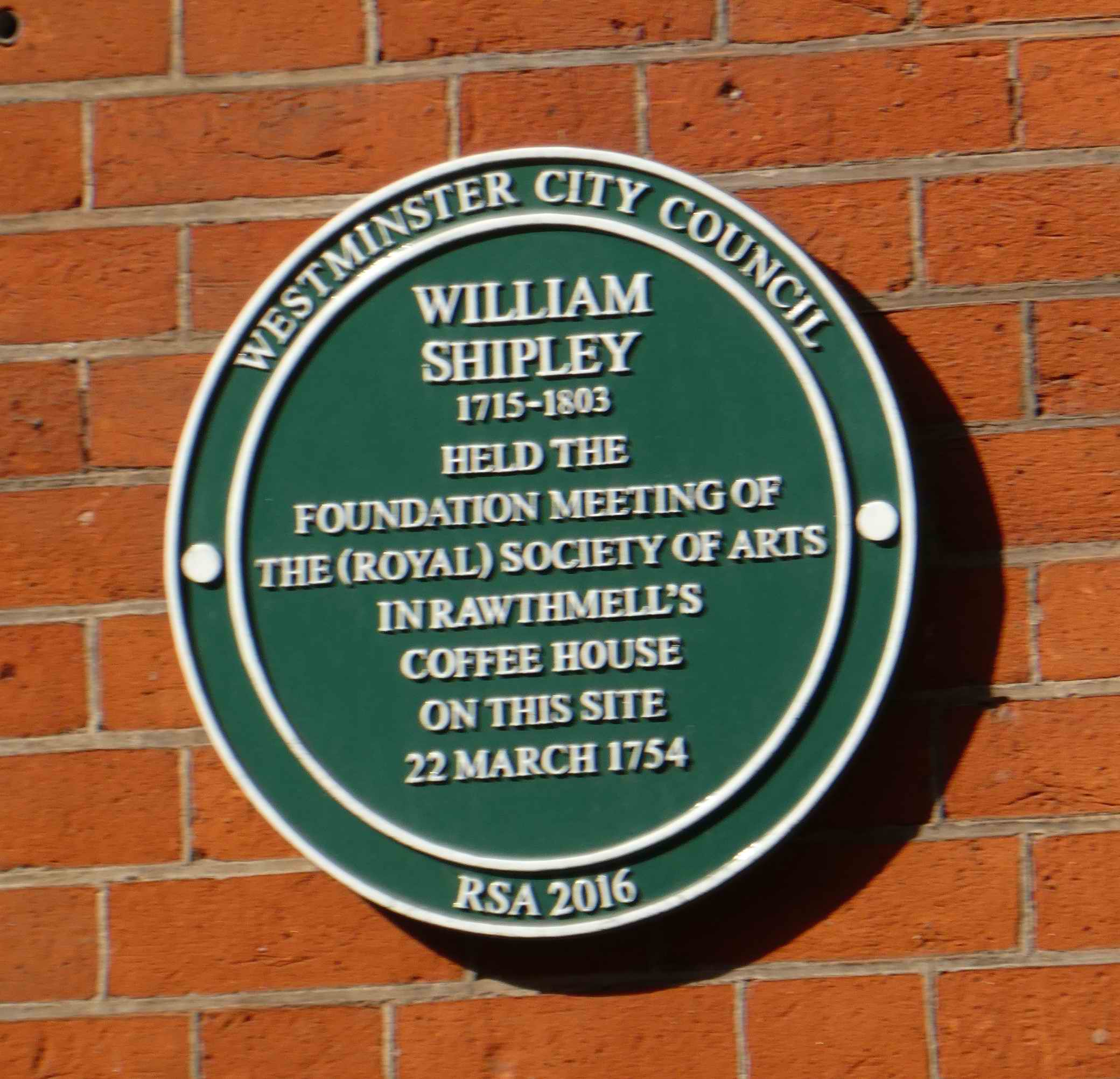
At the end of the road turn left into Bedford Street. Stop when you reach the junction with Maiden Lane, and look right into Chandos Place.
There is a blue plaque to Charles Dickens above TGI Friday’s. He apparently worked there as a boy.
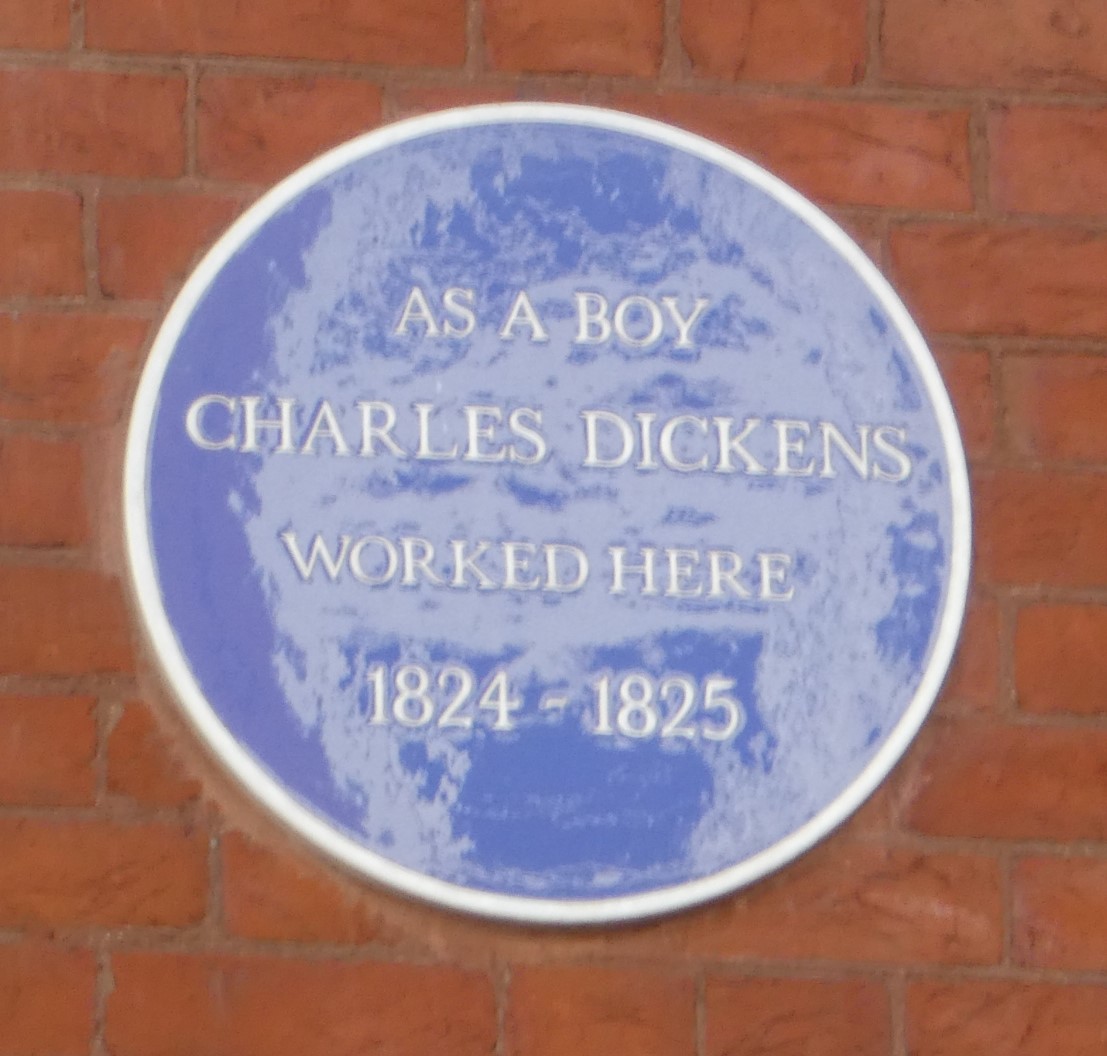
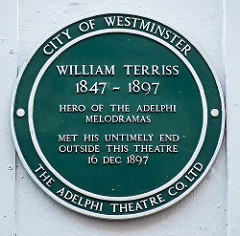
As the narrow road widens slightly, on the right, by the stage door of the Adelphi Theatre, a further green plaque commemorates William Terriss (1847 – 1897) “Hero of the Adelphi melodramas” who “met his untimely end outside this theatre 16 Dec 1897”. Terriss, whose real name was William Charles James Lewin, became one of Britains most popular actors. He was known for swashbuckling hero roles and was also a notable Shakespearian performer.
Terriss had Richard Prince dismissed from an acting role after a disagreement, but Terriss continued to pay him a little, via the Actors’ Benevolent Fund, and tried to find him acting work. However, by the end of 1897 Prince was destitute but unemployable. When his request for money was refused by the Fund, he waited for Terriss at the entrance to the Adelphi. At his trial he was found guilty but insane, so was sent to Broadmoor Asylum, where he died in 1936.
Further details can be found at the website here
Continue along Maiden Lane to No. 10.
(Note that as you pass No. 15, the alley, Bull Inn Court, is the same as is mentioned further on, so a suitable short cut to the Nell Gwynne, should you wish)
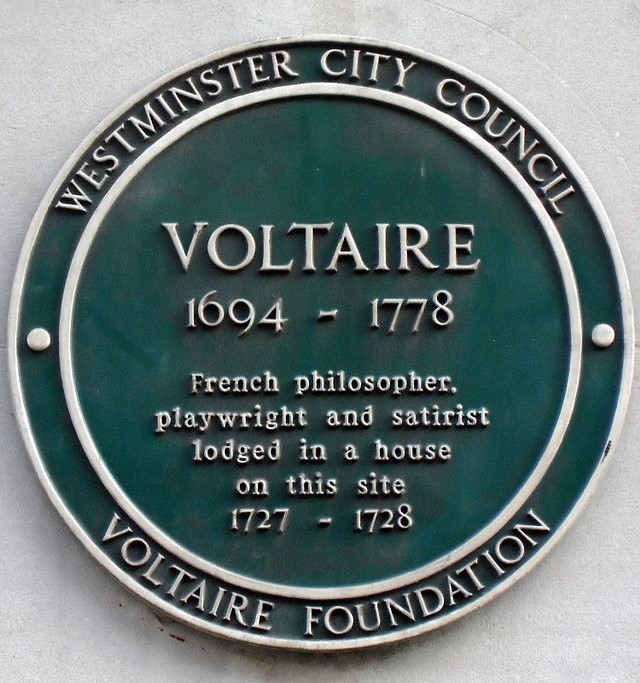
At No.10, a further green plaque confirms that the French philosopher, playwright and satirist, Voltaire (1694 – 1778)
lodged here in 1727 – 1728. He had been exiled to England as an alternative to imprisonment in France, and lodged in
Covent Garden for part of the time, to be close to his publisher. Voltaire circulated throughout English high society and
published essays in English. He was permitted to return to France after two and a half years exile.
At the end of Maiden Lane turn left into Southampton Street, and unless you wish to return to Covent Garden, almost
immediately turn right into Tavistock Street, with its modern gas lights. Pass the London Transport Museum on the
left and continue to the junction with Wellington Street.
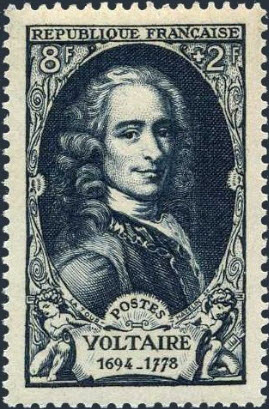
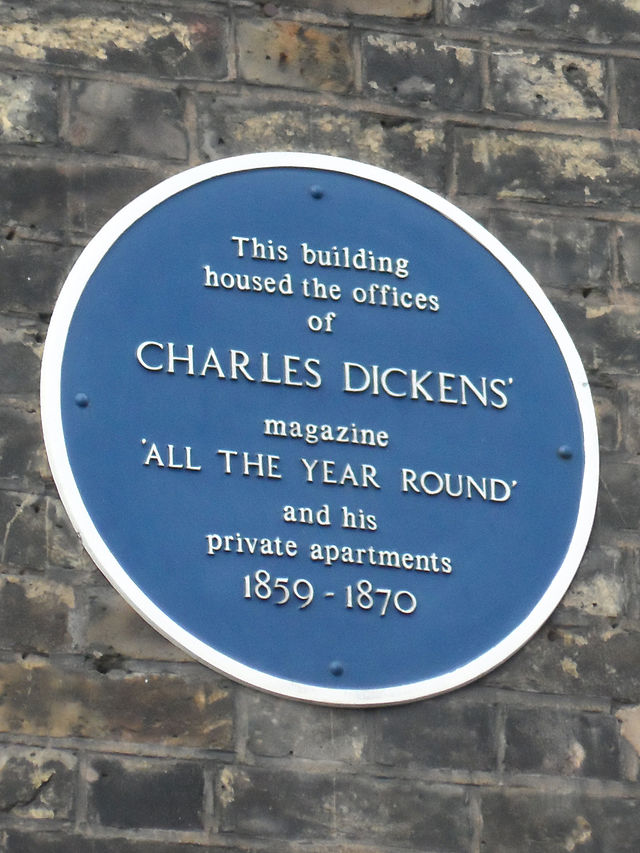
Turn left into Wellington Street, and left into Russell Street.
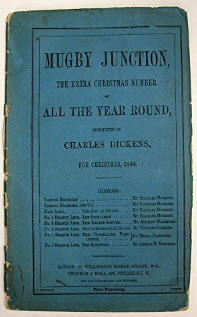
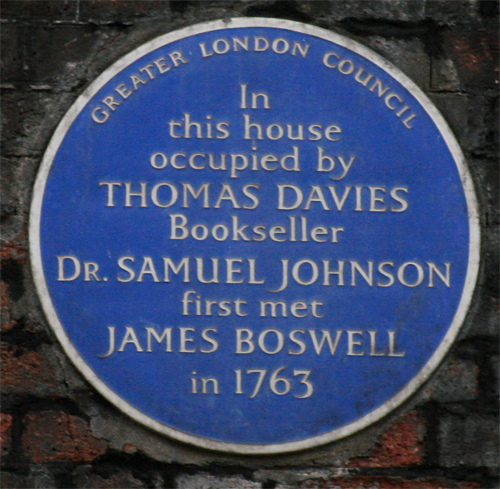
[Boswell:] "Mr. Johnson, I do indeed come from Scotland, but I cannot help it." [Johnson:] "That, Sir, I find, is what a very great many of your countrymen cannot help."
Samuel Johnson was commemorated on the 200th anniversary of his birth, by a stamp in the Eminent Britons series, in 2009.
Retrace your steps along Russell Street and turn left into Bow Street. On the left you soon reach the Royal Opera House.
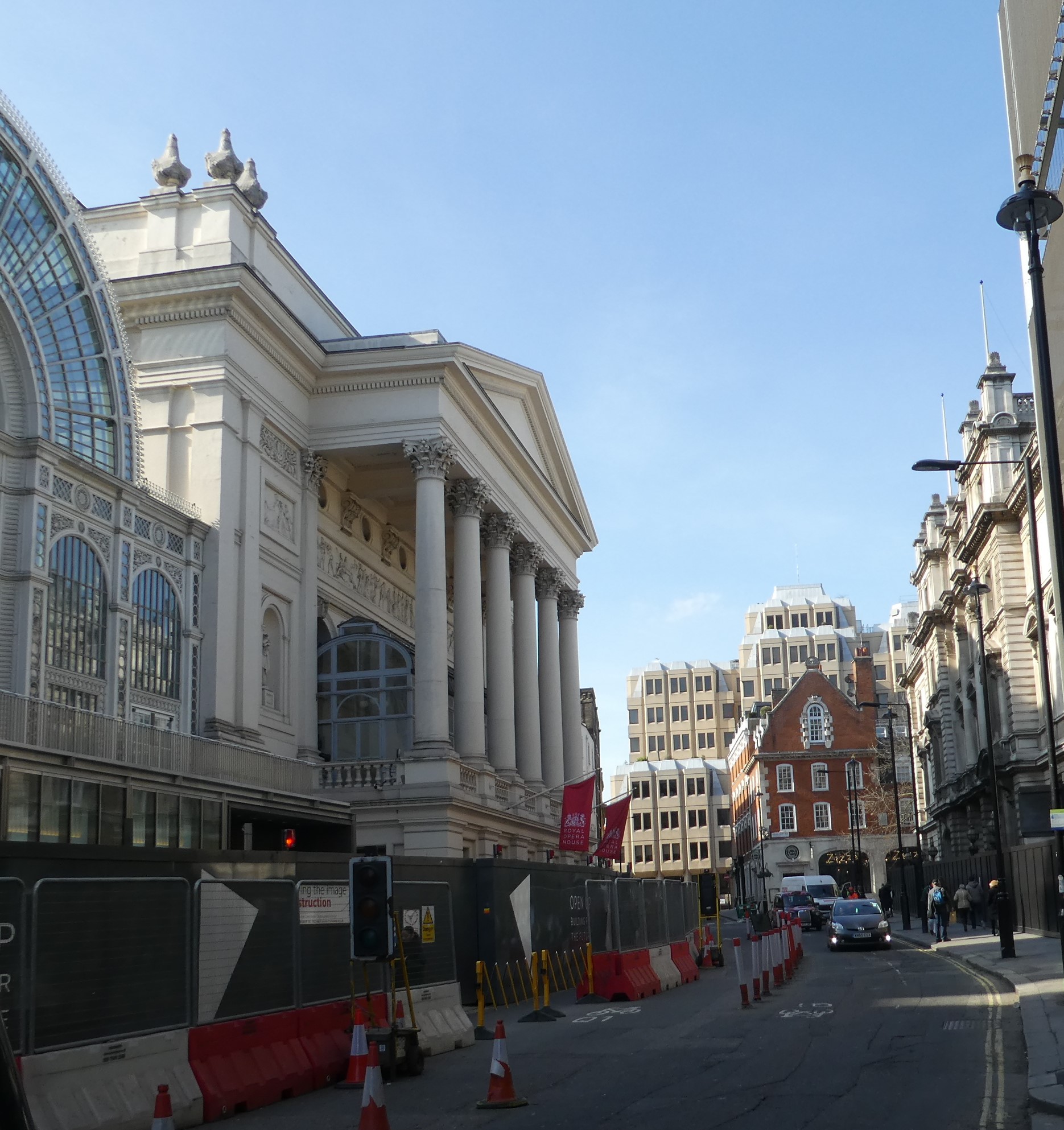
The building is often simply referred to as Covent Garden, after a previous use of the site of the opera house’s original construction, in 1732. The current building is the third theatre on the site following disastrous fires in 1808 and 1856. The facade, foyer and auditorium date from 1858, but almost every other element of the present complex dates from an extensive reconstruction in the 1990’s. You can see the view on the 1980 13½p stamp in the London Landmarks series, from Bow Street.
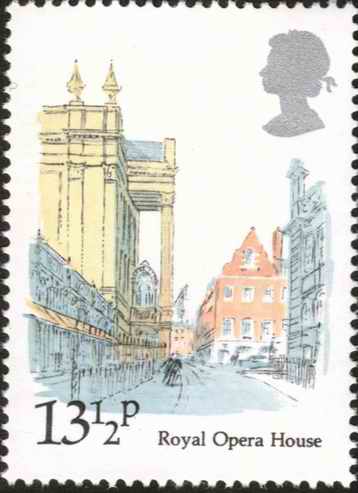
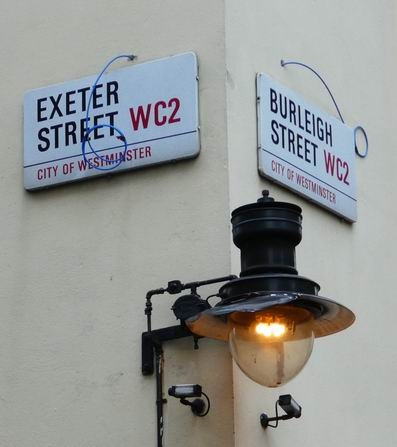
Retrace your steps along Bow Street, but this time cross Russell Street and continue along Wellington Street, cross Tavistock Street, and turn right at the junction with Exeter Street.
Walk along Exeter Street. There is gas lighting, including corner wall mounted gas lamps, at Burleigh Street and as Exeter Street itself, turns to the left. You arrive at Strand, opposite the Savoy Hotel.
Cross Strand carefully, and turn to the right.
A few metres along you reach a freehouse, The Coal Hole, which has a gas lamp adjacent to one of its signs. Turn immediately left into the narrow Carting Lane. Go down the steps.
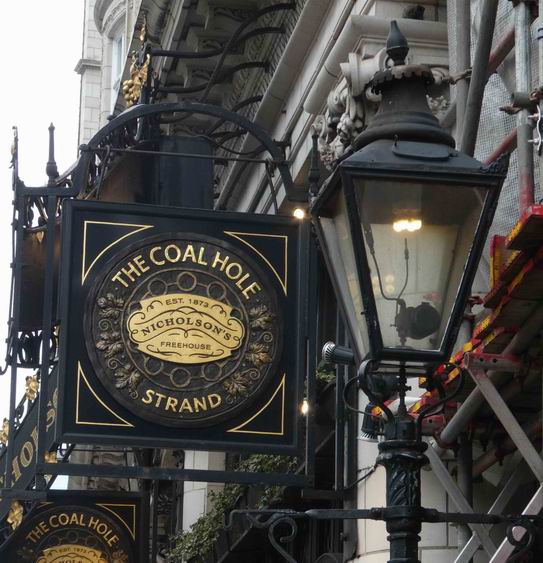
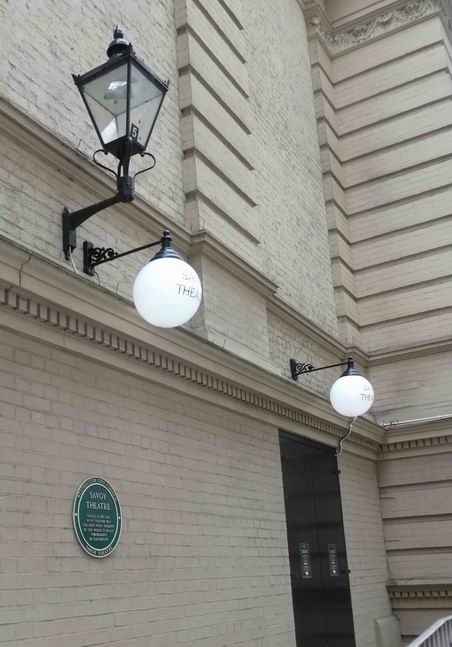
A few metres further on, on the left hand side, you will see three globes inscribed Savoy Theatre. The centre one, with an electric light above, has a Westminster green plaque below with the explanation. These globes commemorate that when it opened in 1881, the Savoy Theatre was the first public building in the world to be lit throughout by electricity.
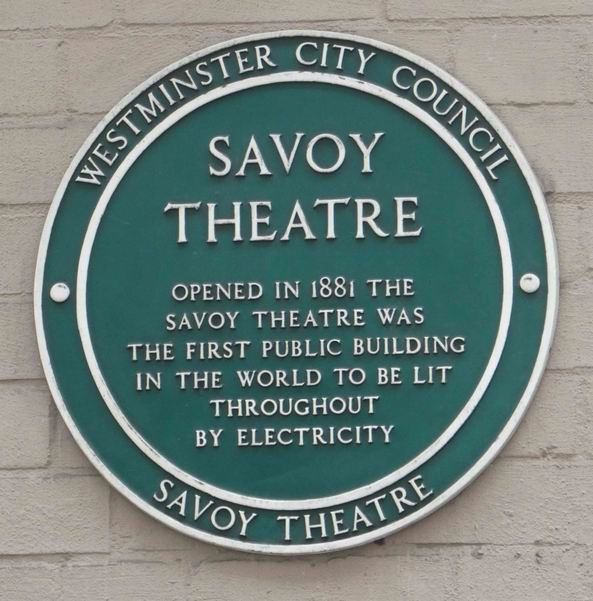
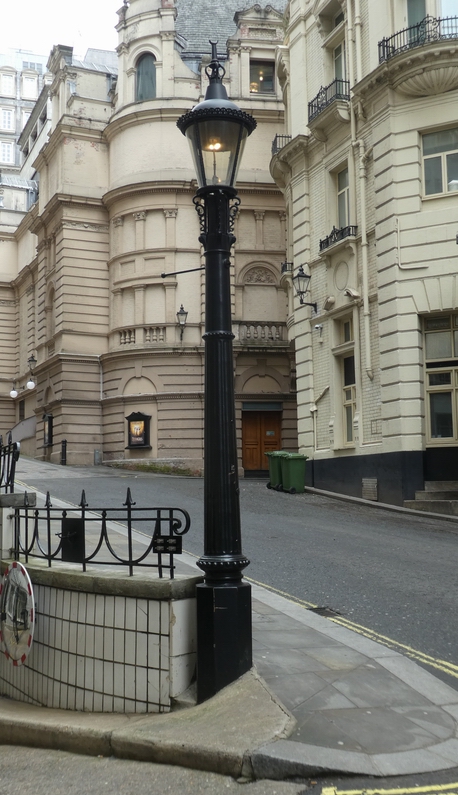
Continue a little further down Carting Lane.
On the right is a gas light with a difference. This is the last remaining example in London of a sewage lamp. The Webb Patent Sewer Gas Lamp was invented in the late 19th century by the Birmingham inventor Joseph Webb. In London the lamps were used for two main reasons; firstly to burn off the smells and germs from London’s sewer system, and secondly as a low cost, low maintenance way to keep London lit up at night.
Methane was collected by a small dome in the roof of the sewer, with the gas then being diverted into the lamp on the street above. The lamp remains lit 24/7, powered at least partly by an almost unlimited amount of waste from guests staying at the nearby Savoy Hotel.
Interestingly, the effluence from the sewers was not actually concentrated enough to fully power the lamps. Instead, the lamps were “dual powered” by ordinary town gas supplies which heated the filament up to around 700 degrees F. This heat then drew the methane and other gases from the sewer system, in turn ventilating up to three quarters of a mile of pipe!
A City of Westminster plaque confirms the nature of this gas light.
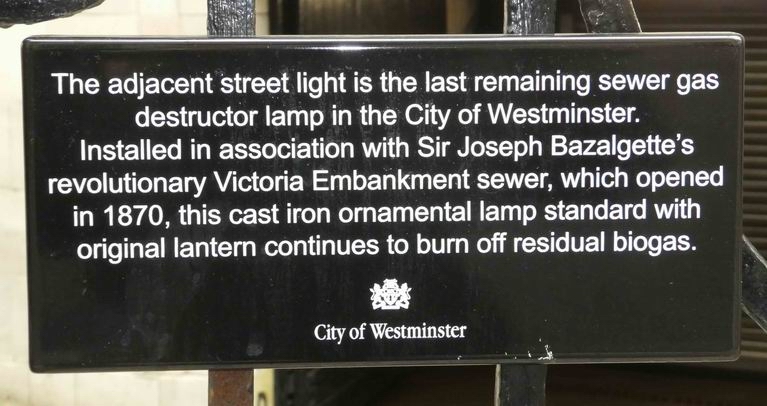
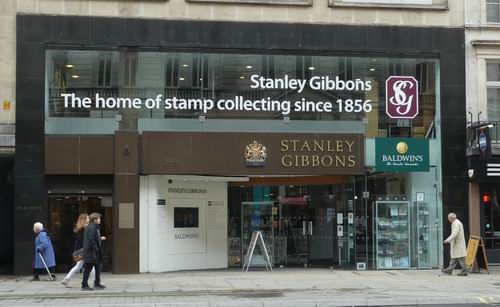
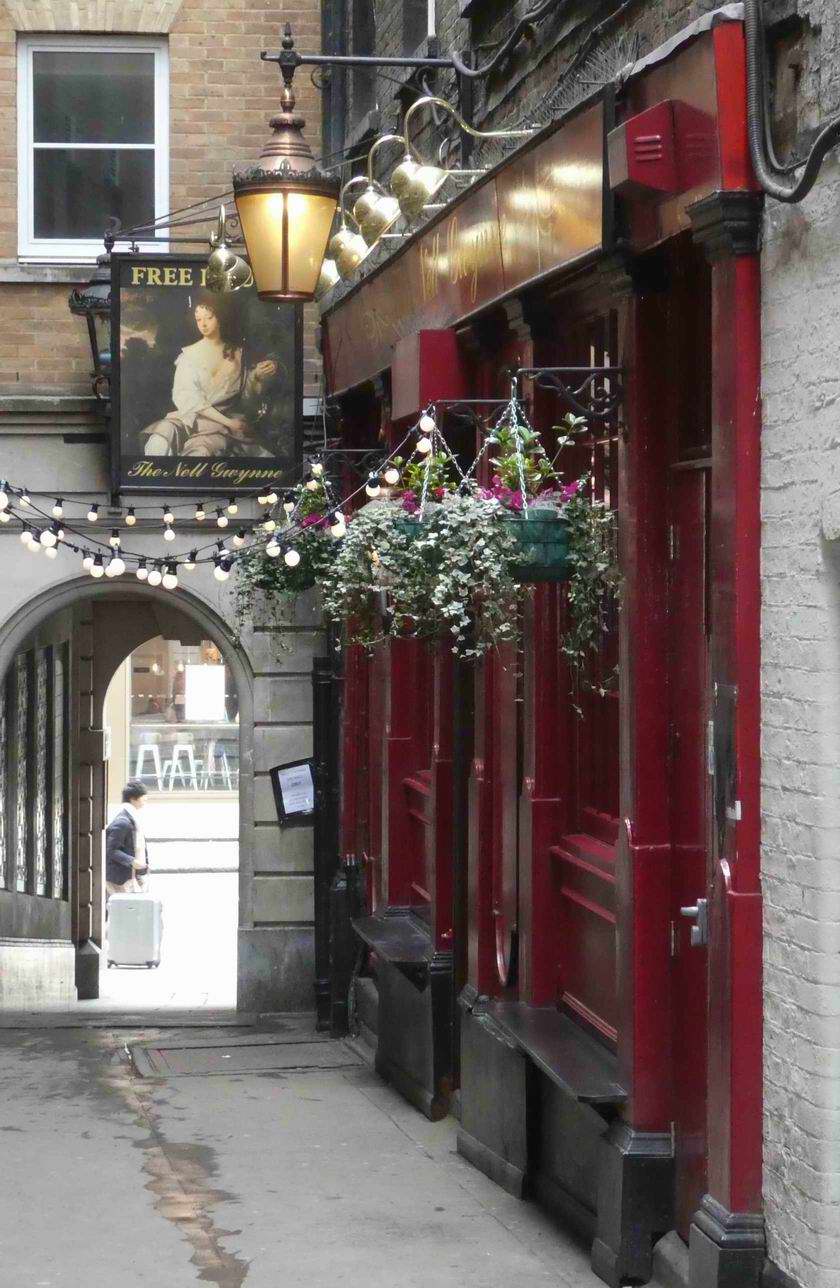
Retrace your steps to Strand and turn left. A few metres along, across the road you'll see Stanley Gibbons, the “home of stamp collecting since 1856”. Assuming you are not drawn into this establishment, cross the road and turn into Lumley Court, just to the left side of Stanley Gibbons. Check out the gas lamp and return to Strand, go along a few more metres and turn into another narrow alleyway, Bull Inn Court, just to the right of 408 Strand. Bull Inn Court, which has gas lights, leads to Maiden Lane, where it comes out close to the Adelphi Theatre.
On the left of Bull Inn Court you’ll find the Nell Gwynne, a traditional pub of a type that is nowadays very rare
in central London. The customers usually extend out into the Court, as space inside is limited.
Nell Gwynne Tavern was built on the site of the Old Bull Inn, and named after the infamous mistress of Charles II. Nell,
born and raised in the locality at St Martin in the Fields, sold fruit in the nearby Covent Garden market before gaining
fame as an actress on the Drury Lane stage. Samuel Pepys describes seeing “the mighty pretty Nell” on his way to the Strand
in 1667. Barnabas Blessed, great-great-grandfather of the actor Brian, was a bookbinder and stationer in the court at the
beginning of the 19th Century. And as already mentioned, in 1897, William Terriss, was murdered a few yards from the pub.
Today, ‘the Nell’ is one of London’s most charming and historic hidden treasures, offering a selection of local beers, wines
and spirits. It also claims one of London’s best jukeboxes, packed with classic old 45 records. A limited menu is served here,
and they specialise in toasties, sausage rolls and giant Scotch eggs. Opening times are Monday to Friday 11.30 – 23.00,
Saturday 12.00 – 23.00 and Sunday 12.00 – 22.00.
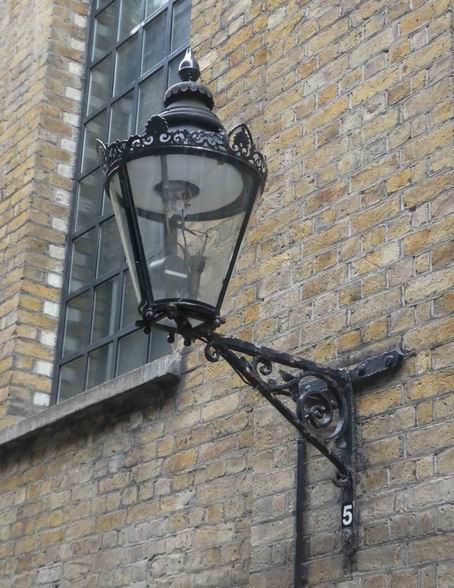
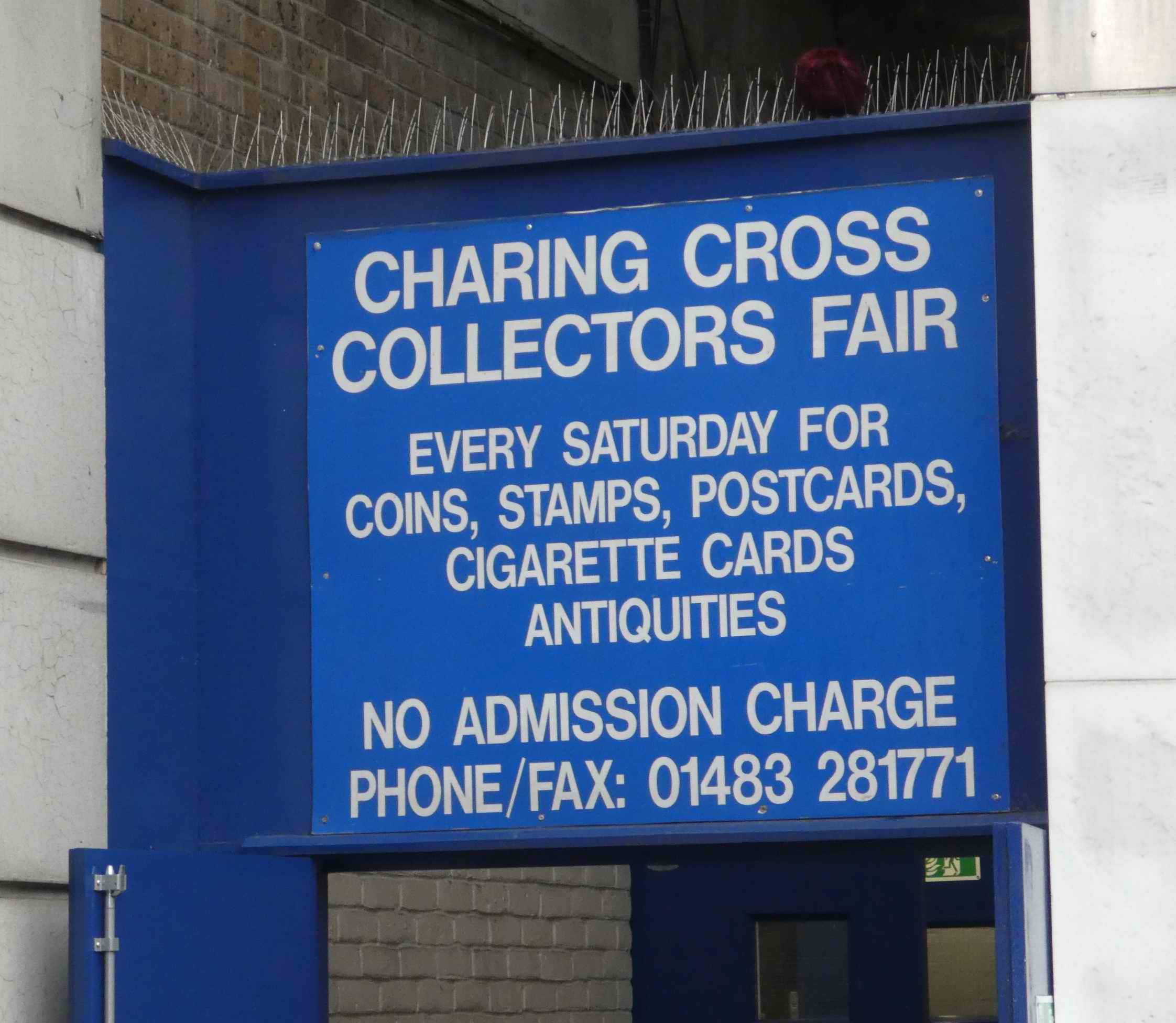
Once you finish in Bull Inn Court, return to Strand, and turn to the right. Cross the road when convenient. You‘ll shortly reach Villiers Street alongside Charing Cross Station.
There’s a collectors market at the lower end of Villiers Street every Saturday from 07.00 – 15.00, in the covered car park opposite Embankment station. There are usually stands with coins, banknotes, post cards and militaria, as well as stamps.
Continue along Strand to the roundabout at Trafalgar Square, then cross both Northumberland Avenue and Whitehall.
If you require refreshment at this point, the Lord Moon of the Mall is recommended, and is only a few metres down Whitehall on your right.
Continue on the roundabout, to the next junction, which is The Mall.
Here you will clearly see Admiralty Arch, which you go through, close to the end of the road. Go along The Mall to the first
main junction on the left, where you turn into Horse Guards Road.
There are gas lights all along Horse Guards Road, on the park side all lights are gas, but on the other side some of the lights
are electric. You will soon reach Horse Guards Parade, where the changing of the Life Guard takes place daily at 11.00, except
on Sunday when it is at 10.00. The ceremony lasts about half an hour, and you can expect much smaller crowds than those at the
Changing the Guard at Buckingham Palace. With no railings between you, and those taking part, it’s ideal for photographs.
Continue along Horse Guards Road to the end, where you turn left into Birdcage Walk and almost immediately right into Storey’s Gate.
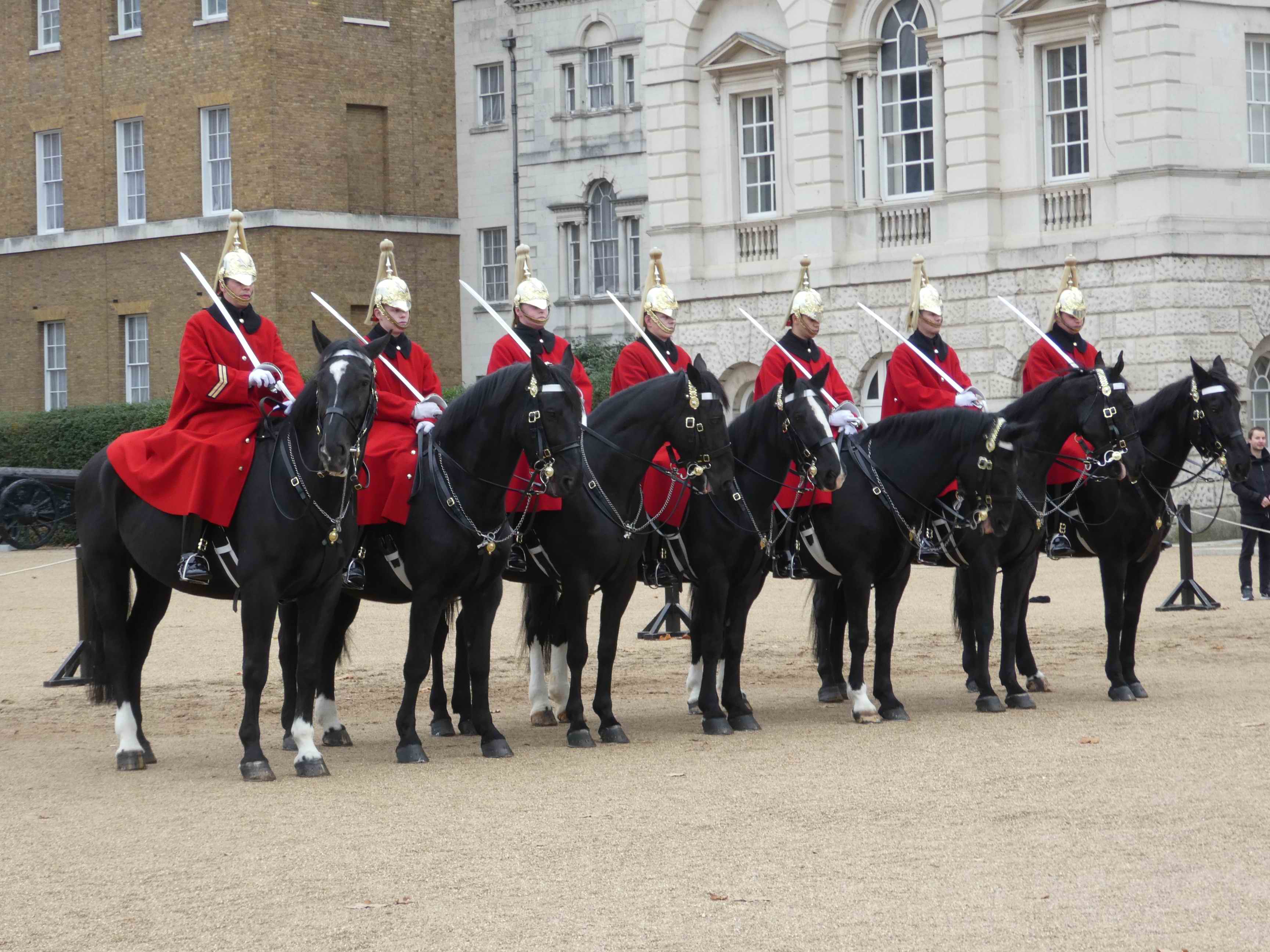
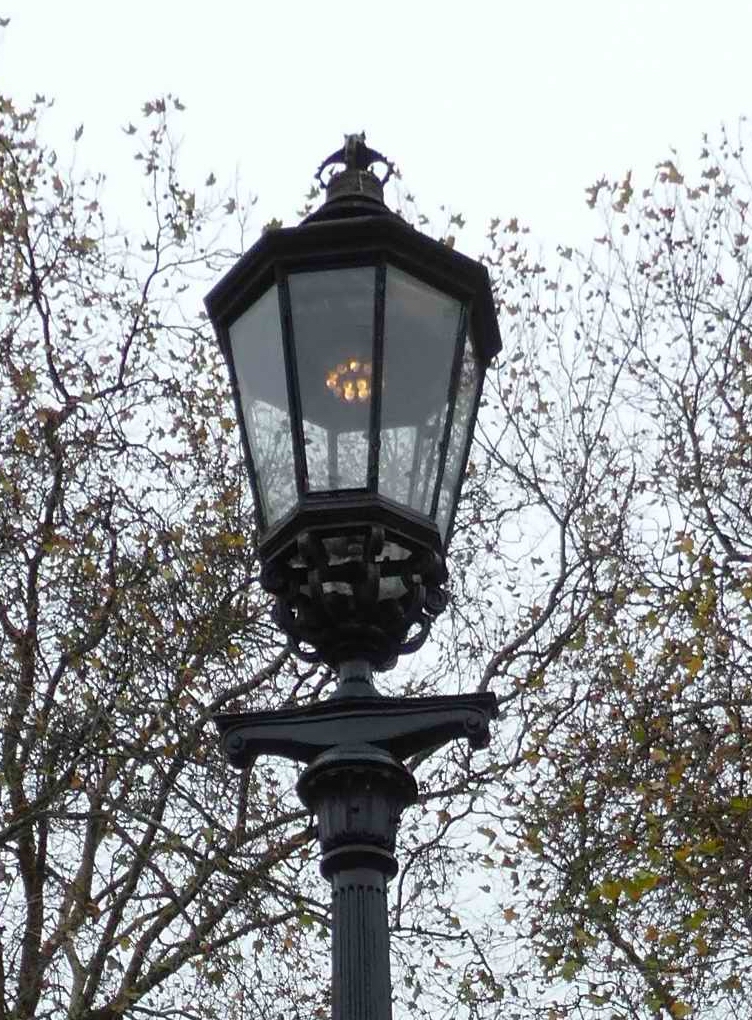
For an early return to Victoria, turn right rather than left, along Birdcage Walk. This returns you to Buckingham Palace, to retrace your steps from earlier. You would then see that Birdcage Walk has gas lighting all along the park side of the road, and that the main paths across St James’s Park are also gas illuminated.
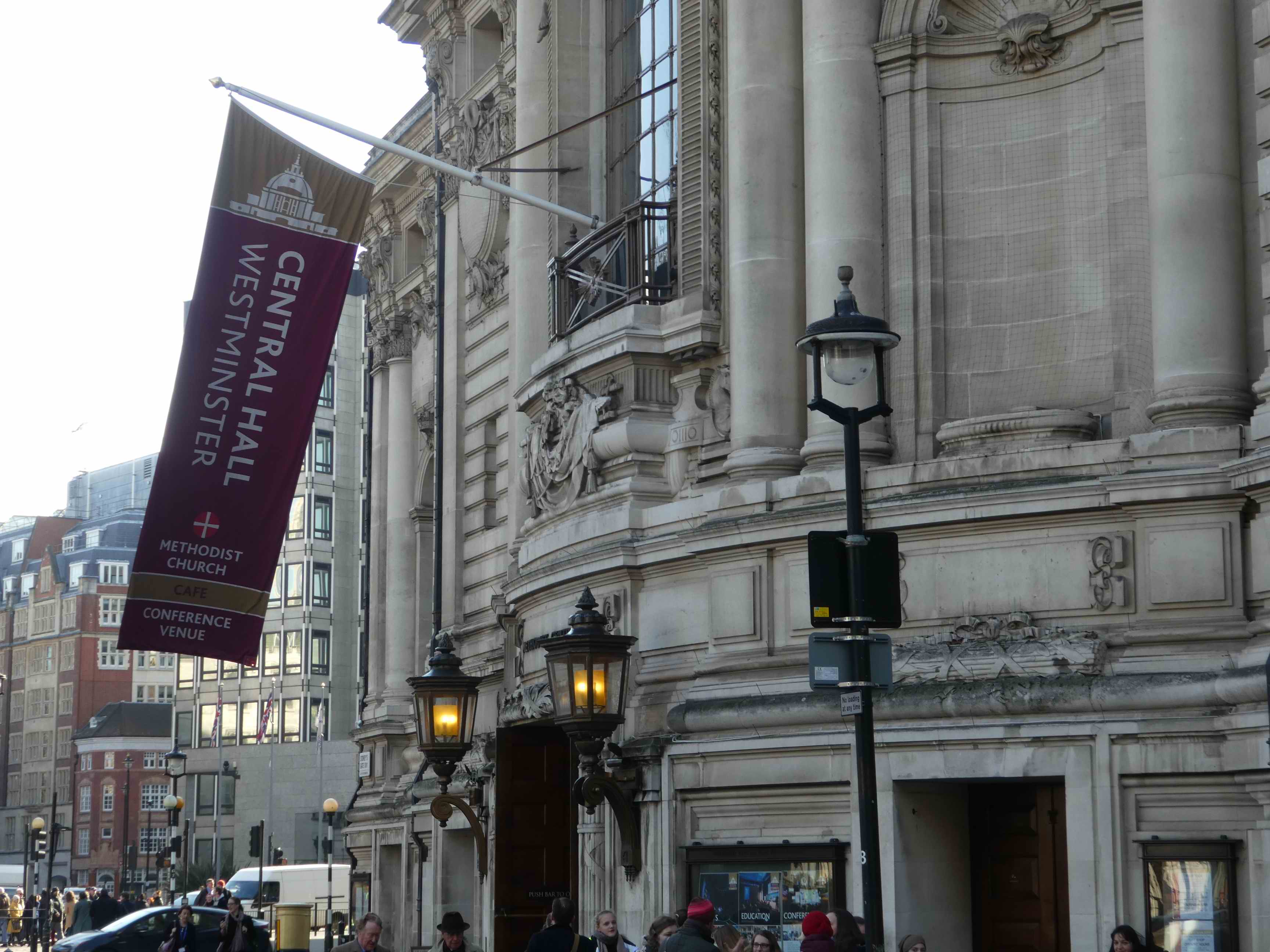
A little before the end you come to the Central Hall, where Stampex, the British National Stamp Exhibition was held from 1954 until 1969, when it moved to the Royal Horticultural Halls, Westminster. On 20th March 1966 the Jules Rimet Trophy, the solid gold prize for the winners of football’s World Cup, was stolen here. It had been displayed at Stampex by Stanley Gibbons, being in the country prior to the World Cup finals taking place. It was fortunately recovered a week later, having been left under a hedge in south east London.

Continue to the end of Storey’s Gate and cross Broad Sanctuary to arrive in The Sanctuary.
This is the open area where you see a tall memorial, the Crimea and Indian Mutiny Memorial, which was erected in 1861.
Cross the Sanctuary, and go through the archway into the Westminster Abbey Precincts, known as Dean’s Yard.
You can walk all round Dean’s Yard, which comprises most of the remaining precincts of the former monastery of Westminster, not occupied by the Abbey buildings. It is a large gated quadrangle, closed to public traffic, surrounding a green upon which Westminster School pupils have legal rights to play football. The buildings of Westminster School, Westminster Abbey Choir School and Church House, the headquarters of the Church of England, occupy the quadrangle. It is a surprisingly quiet and tranquil area in Westminster.
Historically, Westminster Abbey was one of the last ecclesiastical sanctuaries to surrender its ancient rights, which meant that the precincts were largely occupied by undesirable and dangerous inhabitants. This Sanctuary extended beyond Dean’s Yard as far as the north side of Parliament Square, where Thieving Lane was named for the local profession. It is not often remarked that H M Treasury is built upon the site of that lane.
There are several types of gas lights in Dean’s Yard, including old wall mounted lights, some very delicate looking street lamps, and elaborate lamps at the Abbey entrance.
Having looked around Dean’s Yard, exit the way you came in, and look to the right, to the entrance to Westminster Abbey.
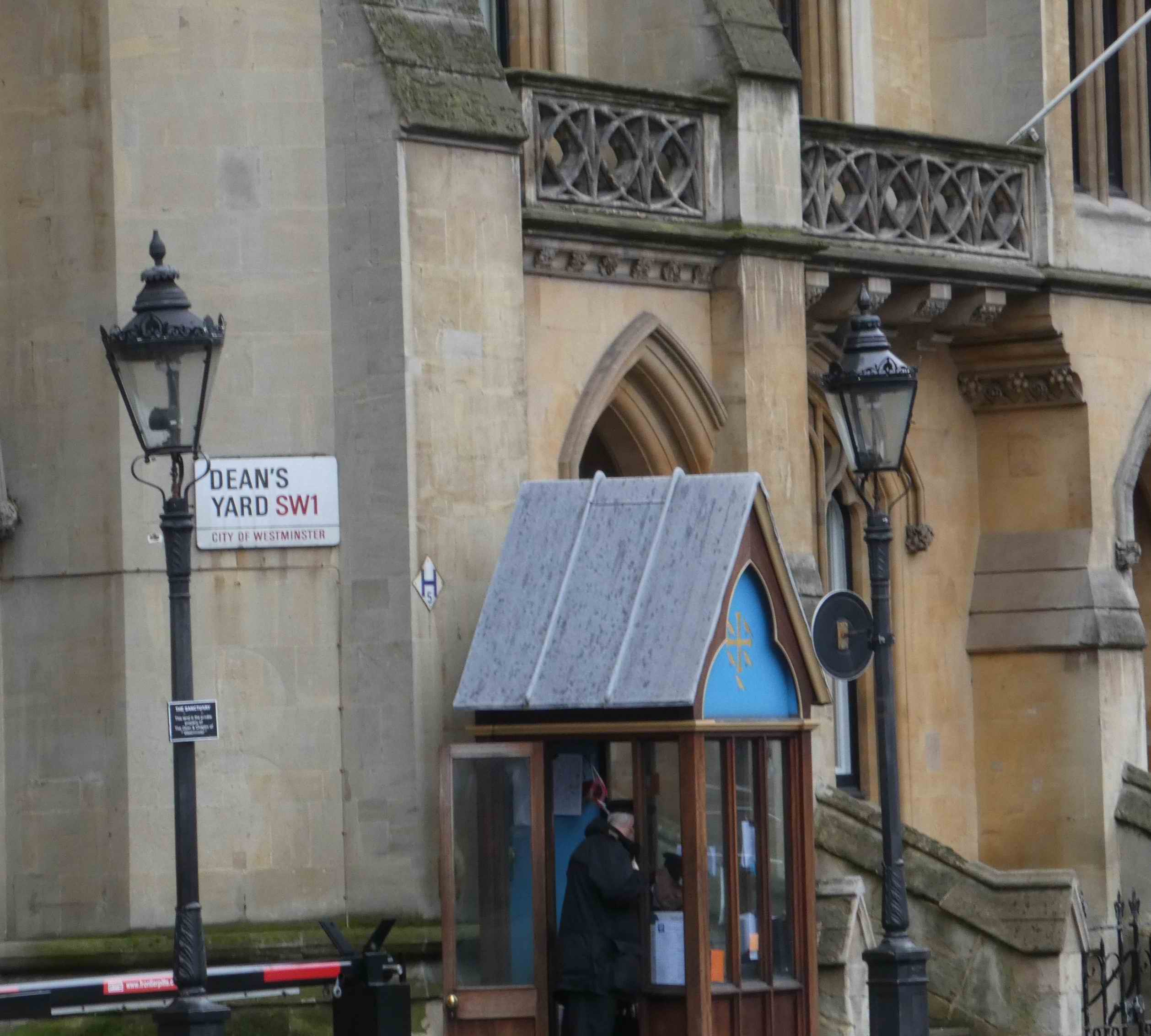
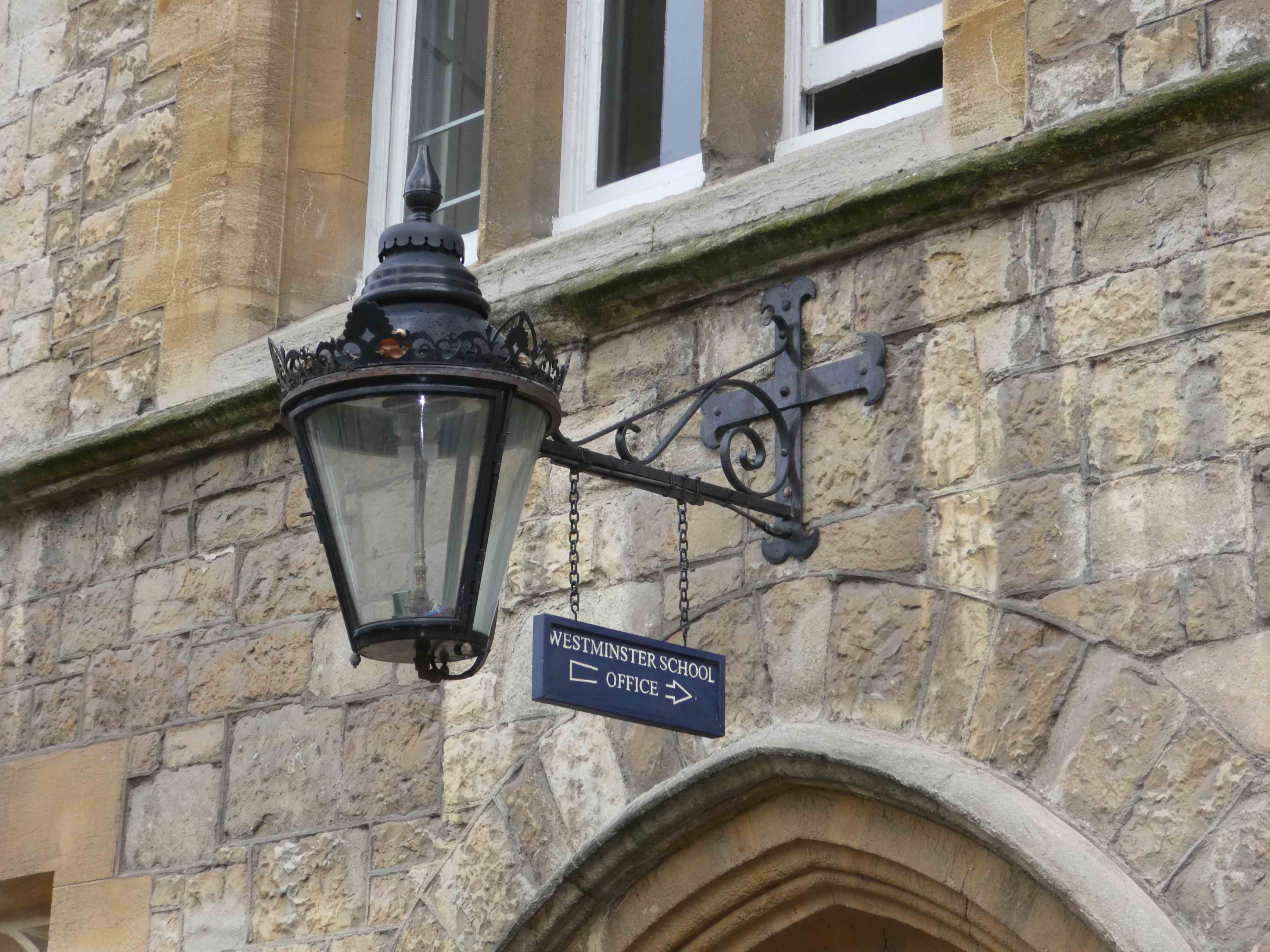
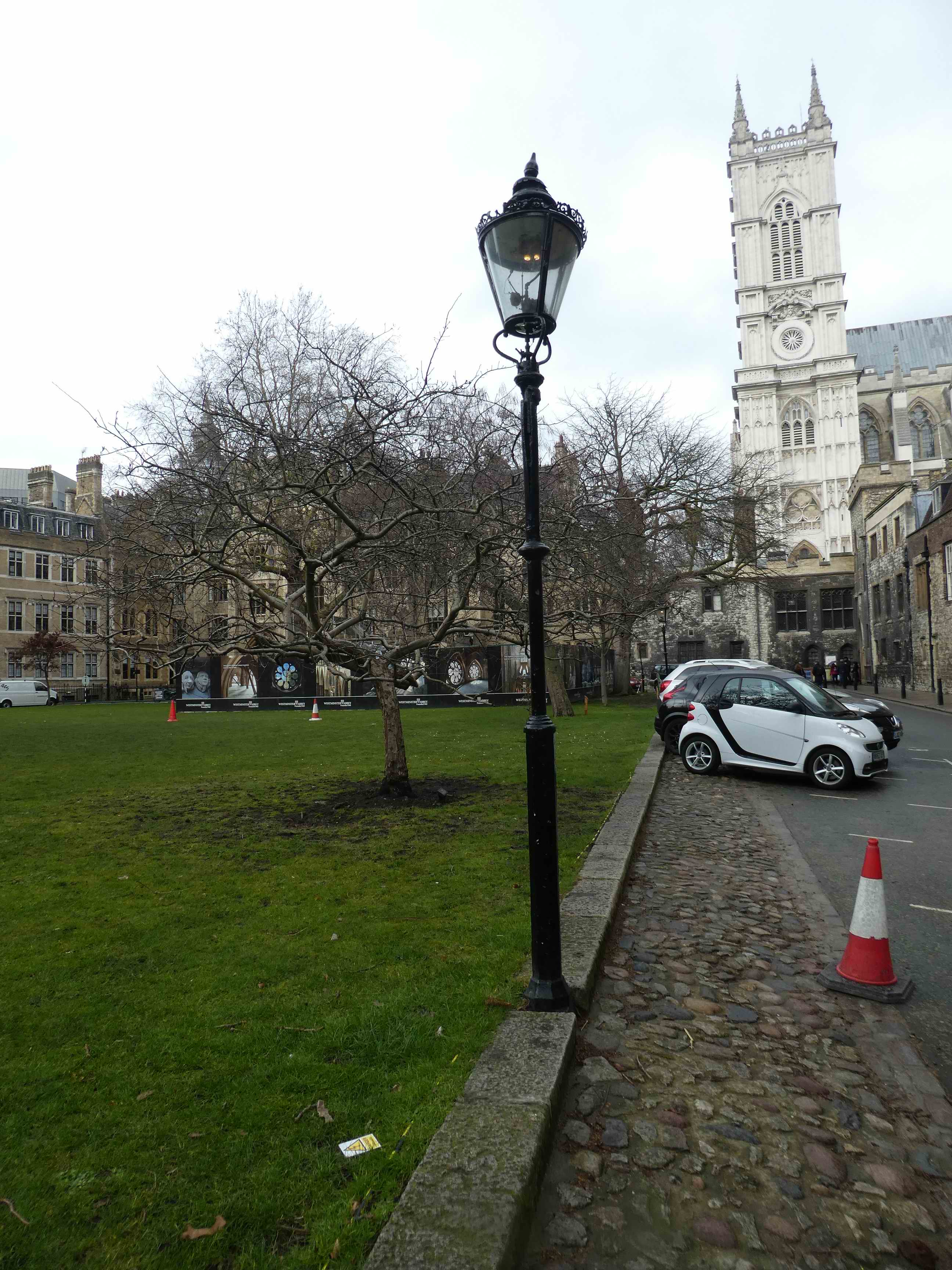
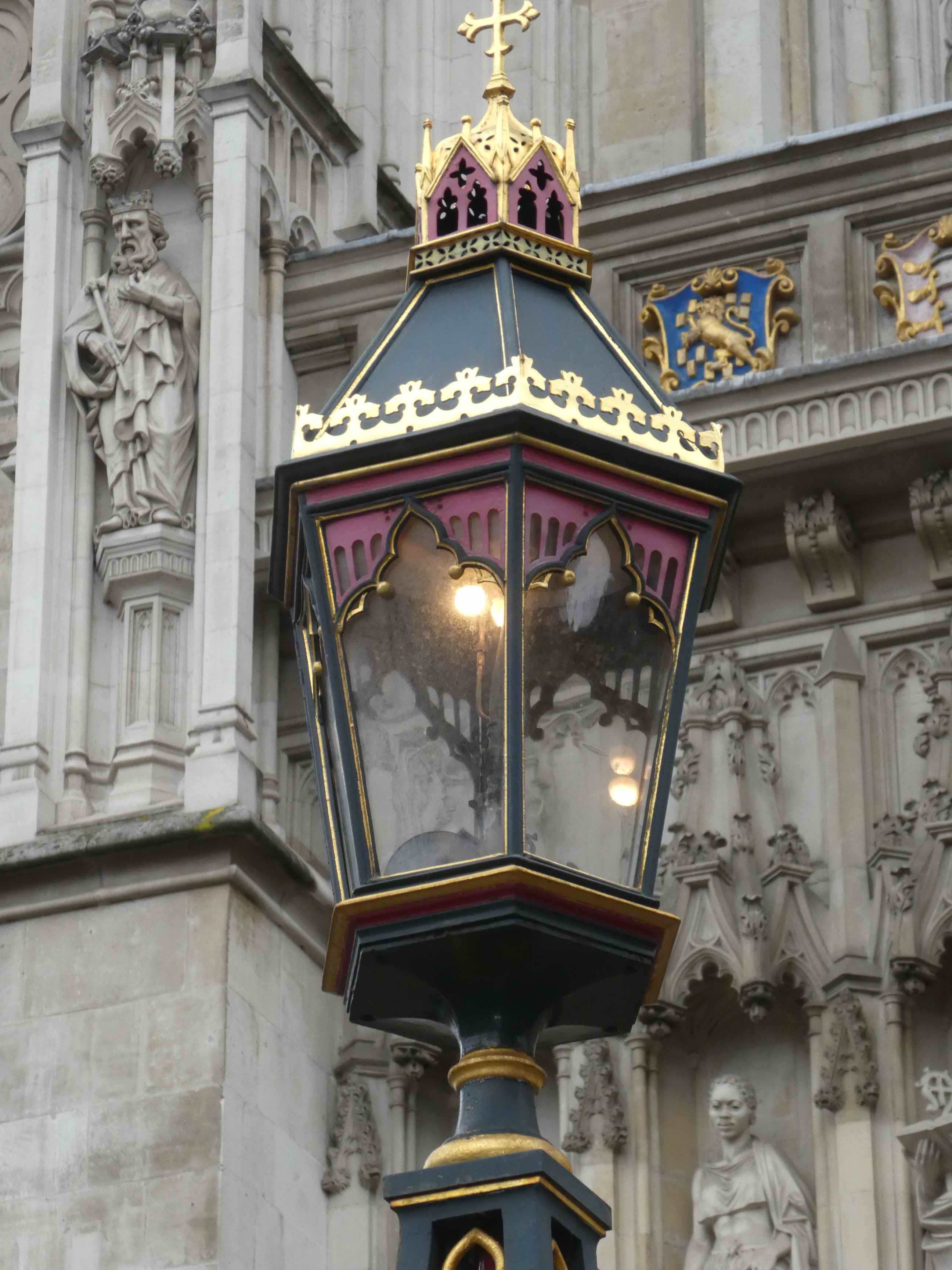
Note here more very elaborate gas lamps at the Abbey entrance, to the left of the shop. Westminster Abbey was subject of a 1966 set of stamps commemorating the 900th Anniversary of its founding.
Now, for the final stop, turn to the left, away from the Abbey. Just after you leave The Sanctuary, take the first turning on the left, which is Great Smith Street. Walk about 300m to the junction with Great Peter Street, cross the road, and turn to the right along Great Peter Street to the end of the first building.
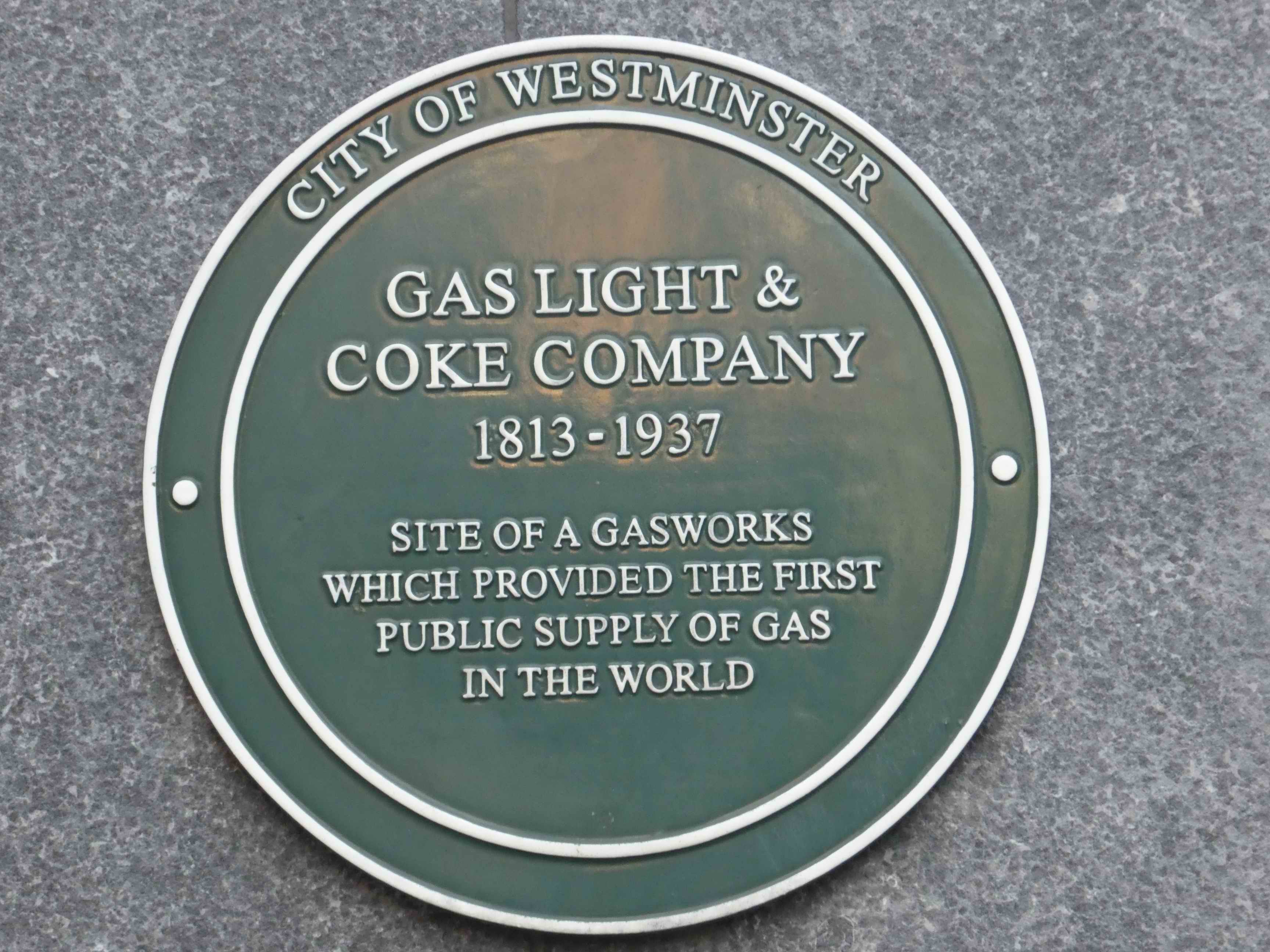
On a pillar at the end of the Seacole Building is a green City of Westminster plaque. This states that you are at the site of the Gas Light and Coke Company (GLCC) gasworks, which provided the first public supply of gas in the world, in September 1813. Pipes were to be laid to the Parliament buildings, but the first paying contract, in November 1813, was with the Church of St. John (now the concert venue St John’s Smith Square) en-route to there. The use of gas rapidly expanded over the next few years so by September 1815 the mains had extended as far as the Covent Garden Theatre (now the Royal Opera House), where around 80 lamps were installed.
The gas works grew to occupy a large site here, through to Horseferry Road, where the GLCC had their offices for many years (extract from 1862 map shown). The gas works was closed in 1875 as the company used larger and more efficient works. The Seacole Building (named after the Jamaican nurse Mary Seacole, heroine of the Crimean War), is part of the headquarters of the Home Office.
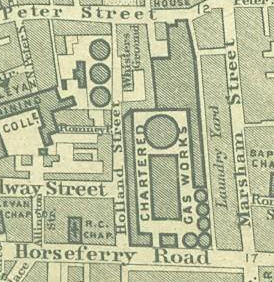
This concludes the walk. For return travel, the closest underground station is St James’s Park, which you can reach in about 650 metres by retracing your footsteps along Great Peter Street and Great Smith Street to Victoria Street, where you cross and turn immediately left into Tothill Street (across Victoria Street from The Sanctuary), and the station is about 250 metres along Tothill Street.
Alternatively, to return to the start point at Victoria is about 1,100 metres. To do this, continue walking along Great Peter Street in the direction you were going. Straight on at the first mini roundabout into Greycoat Place (The Grey Coat Hospital on left), then follow Greycoat Place to the right at the next mini roundabout and turn right (by “The Greencoat Boy”) into Artillery Row to Victoria Street, where you turn left and continue, to reach Victoria station.
For refreshment here, follow Victoria Street past Westminster Cathedral (on left) towards the Station, cross the road at the Clock as though going to the station, but turn left into Wilton Road, immediately in front of the station. You'll find "The Willow Walk" a few metres along. This is likely to be more enjoyable than available refreshments in the station!
